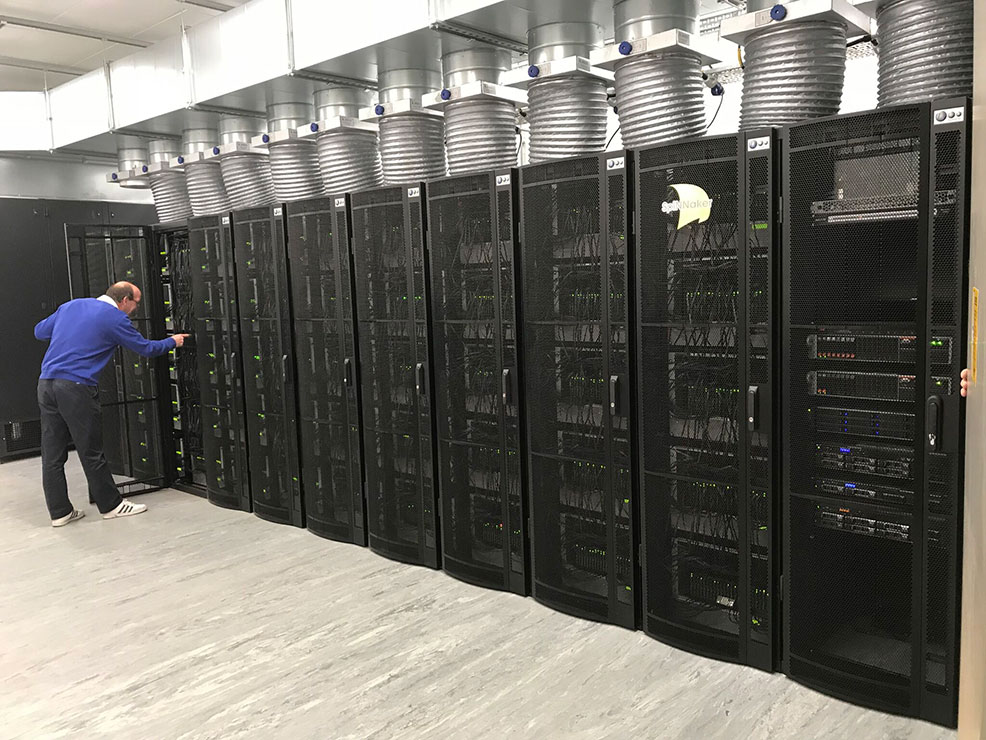
3rd November 2018 World’s largest neuromorphic supercomputer is operational The world’s largest neuromorphic supercomputer, the million-core 'SpiNNaker' machine, has been switched on by the University of Manchester, England.
A new supercomputer designed to work in the same way as a human brain has been fitted with its landmark one-millionth processor core and switched on for the first time. The "Spiking Neural Network Architecture" or "SpiNNaker" machine is capable of more than 200 trillion actions per second, with each of its chips having 100 million moving parts. To reach this point has taken £15 million in funding, 20 years in conception and 12 years of construction. The project was initially funded by the UK's Engineering and Physical Sciences Research Council (EPSRC) and is now supported by the European Human Brain Project (HBP). It was switched on for the first time at an event yesterday afternoon. The SpiNNaker machine can model more biological neurons in real time than any other computer on the planet. Biological neurons are basic brain cells present in the nervous system that communicate primarily by emitting "spikes" of electro-chemical energy. So-called "neuromorphic" computing can mimic these spikes using large-scale systems containing electronic circuits. Unlike traditional computers, SpiNNaker doesn't communicate by sending large blocks of data from point A to B via a standard network. Instead, it mimics the massively parallel architecture of the brain – sending billions of small chunks of information simultaneously to thousands of different destinations. "SpiNNaker completely re-thinks the way conventional computers work," says Steve Furber, a Professor of Computer Engineering at Manchester University. "We've essentially created a machine that works more like a brain than a traditional computer, which is extremely exciting. The ultimate objective for the project has always been a million cores in a single computer for real time brain modelling applications, and we have now achieved it, which is fantastic."
Professor Furber aims to eventually model a billion biological neurons in real time, and that goal is now a step closer. For comparison, this is 10 times larger than a mouse brain (which consists of 100 million neurons), while a human brain contains just under 100 billion. The SpiNNaker will therefore replicate approximately 1% of the scale of a human brain. The neurons in a human brain are all highly interconnected via approximately one quadrillion (that's 1 with 15 zeros) synapses. The neuromorphic supercomputer now installed at Manchester University can perform a number of important scientific roles. Its primary function will be to help neuroscientists understand the fundamental workings of the human brain – by running extremely large-scale, real-time simulations that simply aren't possible on other machines. For example, SpiNNaker has already been used to simulate high-level, real-time processing in a range of isolated brain networks. This includes an 80,000 neuron model of a segment of the cortex, the outer layer of the brain that receives and processes information from the senses. It has also simulated the Basal Ganglia – an area affected in Parkinson's disease, meaning it has massive potential for pharmaceutical testing. The power of SpiNNaker has even been used to control a robot, called the "SpOmnibot". This used the neuromorphic system to interpret visual information in real-time and navigate towards certain objects, while ignoring others. Professor Furber added: "Neuroscientists can now use SpiNNaker to help unlock some of the secrets of how the human brain works by running unprecedentedly large-scale simulations. It also works as real-time neural simulator that allows roboticists to design large-scale neural networks into mobile robots so they can walk, talk and move with flexibility and low power."
Comments »
If you enjoyed this article, please consider sharing it:
|








